What Is Thematic Analysis?
- Definition and purpose
- Thematic analysis is a widely used qualitative analysis method for identifying, analysing, and reporting patterns of meaning within qualitative data. This can also be applied in the development of a thematic essay.
- A thematic analysis example can be drawn from qualitative research in psychology, health, or education where researchers seek to understand people’s experiences.
- Unlike quantitative research, which focuses on numerical patterns, thematic analysis emphasises interpretation, meaning, and context.
- This article provides an in-depth thematic analysis example that you can use as a practical guide.
- Flexibility of the method
- It is a qualitative approach that can be adapted across different research designs and research topics.
- Researchers may use thematic analysis for interview transcripts, focus groups, or open-ended surveys.
- A thematic analysis example often demonstrates how researchers link raw data to overarching research aims and objectives.
- Relevance for new researchers
- Those new to qualitative research often start with thematic analysis because it is an accessible analysis method.
- The handbook of research methods highlights thematic analysis as one of the most practical qualitative research methods.
- A thematic analysis example helps early researchers grasp the process of reflexive thematic analysis step by step.
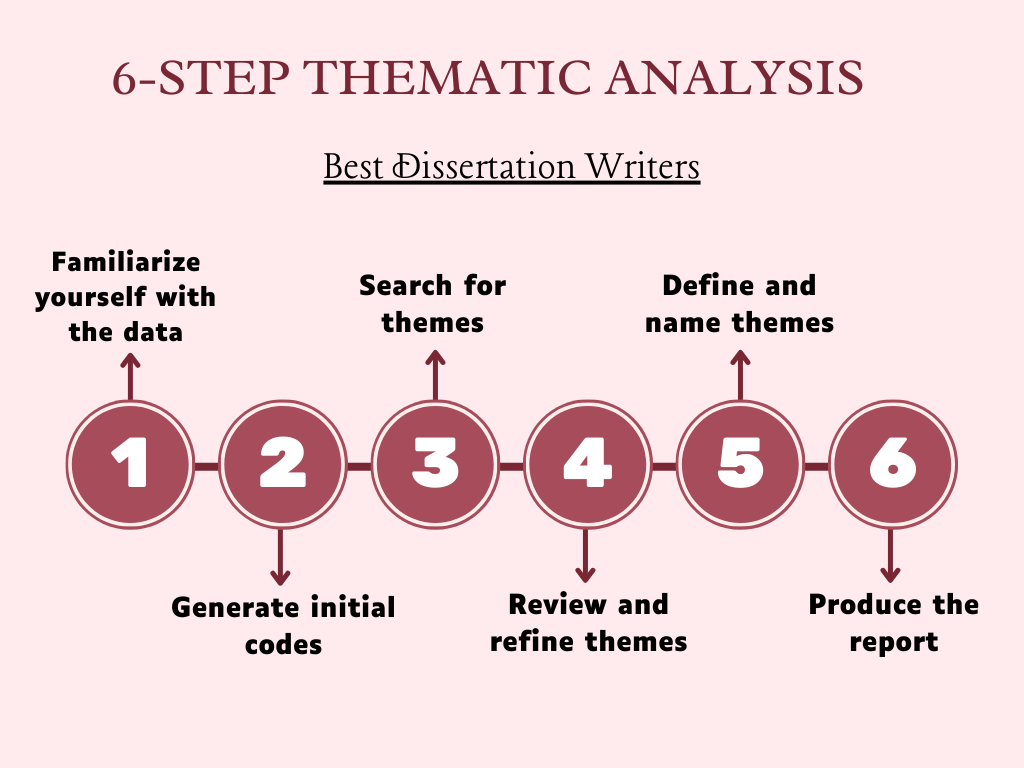
Understanding Reflexive Thematic Analysis
- Origins and scholars
- Virginia Braun and Victoria Clarke introduced thematic analysis in their seminal paper (2006) and have refined it through later publications such as the handbook of research methods in psychology.
- Braun et al argue that their approach, known as reflexive thematic analysis, differs from rigid thematic framework or framework analysis approaches.
- Core principles
- Reflexive thematic analysis requires researchers to actively reflect on their role, decisions, and interpretations throughout the analysis process.
- It acknowledges the relation to the research focus, researcher subjectivity, and the research process as central, not peripheral.
- A thematic analysis example based on Braun and Clarke’s approach shows how meaning is co-constructed between researcher and participant.
- Process
- The process of reflexive thematic analysis involves moving from data collection and analysis to identifying themes that address the research question.
- A stage in the analysis often involves reading and re-reading the interview transcript, developing coding and theme labels, and refining the thematic map.
How To Use Thematic Analysis Qualitative Research?
- Step-by-step process
- Familiarisation with the data – Reading and reflecting on qualitative data such as interview transcripts.
- Generating initial codes – Conducting coding and analysis by tagging significant features of the data.
- Searching for themes – Grouping codes into potential themes, a critical part of the analysis.
- Reviewing themes – Checking coherence and relation to the research focus.
- Defining and naming themes – Clarifying the themes in qualitative data.
- Producing the report – The write-up of the analysis where findings are linked to the research project.
- Inductive and deductive strategies
- Researchers may follow an inductive approach (themes emerge from data) or a deductive analysis (themes guided by theory).
- Both strategies are common in qualitative research methods in health and education.
- Worked illustrations
- Providing a worked example makes the analysis process clear.
- A thematic analysis example illustrates how to conduct thematic analysis by showing coding decisions and how they evolve into themes.
Comparison Between Content Analysis and Thematic Analysis
- Similarities
- Both are methods of analysing qualitative data and can be applied to qualitative data analysis.
- Both approaches allow researchers to explore meanings within interview transcripts and textual material.
- Differences
- Content analysis focuses more on counting and categorising words or concepts, sometimes leaning closer to quantitative research traditions.
- Thematic analysis emphasises interpretation, providing a more flexible approach to qualitative inquiry.
- A thematic analysis example highlights deeper exploration of meanings, whereas thematic content analysis may focus on surface frequency counts.
- Integration
- Scholars often contrast content analysis and thematic analysis in research courses.
- Discourse analysis, framework analysis, and thematic analysis are also compared as distinct approaches to conducting thematic analysis.
Dissertation Help
Expert help from start to finish.
- Topic selection and proposal support
- Chapter-by-chapter dissertation writing
- Editing and proofreading help
Free Consultation
Talk to our experts before you begin.
- One-on-one discussion of your project
- Guidance on methodology and structure
- Tailored advice for your research goals
Evaluating Different Approaches to Thematic Analysis
- Variations in practice
- There are different approaches to thematic analysis, ranging from coding reliability to Braun and Clarke’s reflexive thematic analysis.
- Some scholars use structured thematic framework techniques, while others prefer the flexible form of thematic analysis advocated by Braun and Clarke’s approach.
- Strengths
- Accessible to qualitative researchers across disciplines.
- Useful for existing research and for those designing a new research project.
- Can be applied to a variety of research questions and research methods.
- Limitations
- Requires researcher reflexivity and transparency to avoid superficial results.
- A weak analysis could result from descriptive rather than interpretive themes.
- Applications
- Widely used in qualitative research methods in health and qualitative research in psychology.
- Supports the research aims of exploring lived experience, social practices, and cultural meanings.
- Final thought
- Using reflexive thematic analysis means seeing the researcher as an active participant in meaning-making.
- A well-documented thematic analysis example helps ensure clarity for those evaluating the approach to TA (thematic analysis).
Thematic Analysis Example | 6-Step Guide
Thematic analysis in qualitative research is one of the most widely used methods for exploring experiences, attitudes, and perceptions in psychology. It is a flexible qualitative approach that enables researchers to capture patterns of meaning in participants’ accounts and present them in a structured, interpretive way. The method was first developed by Braun and Clarke in their seminal paper in 2006, and since then it has become a cornerstone of qualitative research in psychology.
In this thematic analysis example, the context of the research is a study exploring how young adults experience and cope with social anxiety in university settings. The nature of the research is exploratory, and the research aim is to understand the lived experiences of students managing social anxiety, including how they perceive support and barriers to adjustment. The study’s guiding research questions were:
- How do university students describe the challenges of living with social anxiety?
- What coping mechanisms do they use to manage social anxiety in social and academic contexts?
- What forms of support do students perceive as most helpful or lacking?
The dataset consisted of 12 semi-structured interviews. What follows is a detailed demonstration of each step in Braun and Clarke’s approach, including examples that flow consistently from one phase to another.
Step 1: Familiarisation With the Data
- Explanation
- The first step involves immersing oneself in the dataset. Researchers must read and re-read transcripts, listen to recordings, and begin identifying striking points.
- This stage is not just passive reading: as Braun and Clarke have made clear, familiarisation is interpretive. It marks the beginning of the analysis of the data, and preliminary notes are usually made.
- Example
- During familiarisation, one participant said: “In lectures, I avoided sitting at the front because I thought everyone was watching me. I often felt so tense that I couldn’t focus.”
- Notes were made about fear of visibility, avoidance strategies, and tension impairing concentration.
- Another participant commented: “I joined a small study group and that helped. Talking with a few peers was easier than being in big seminars.”
- Here, notes focused on peer support and small-group coping.
- Reflection
- The overall analysis began to take shape. Familiarisation suggested that experiences clustered around avoidance, coping, and perceptions of support. These ideas would later inform the thematic structure.
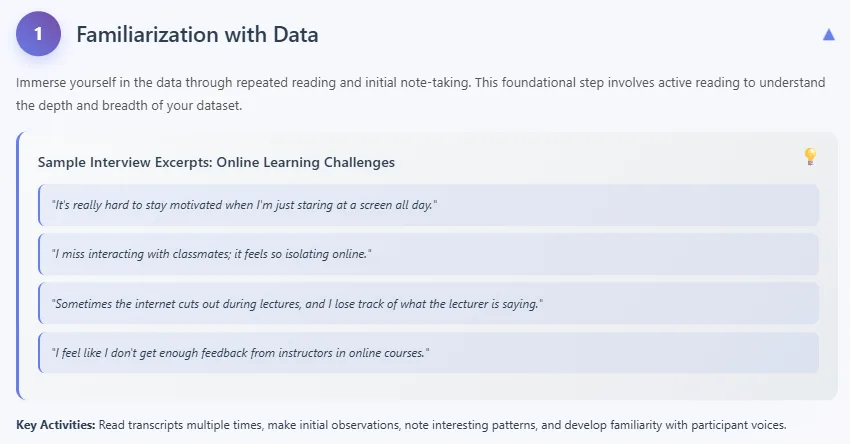
Step 2: Generating Initial Codes
- Explanation
- The coding process is systematic. It involves assigning labels to meaningful features of the data relevant to the research questions.
- Codes can be semantic (surface level) or latent (underlying meaning). This stage produces a large number of codes which will later be refined.
- Example
- From the first extract (“I avoided sitting at the front…”), two codes were created:
- Avoidance of social exposure.
- Anxiety impairing concentration.
- From the second extract (“I joined a small study group…”):
- Small groups as supportive.
- Peer connection as coping.
- A short example of the coding table: Data Extract Initial Code “I avoided sitting at the front…” Avoidance of social exposure “…so tense I couldn’t focus” Anxiety impairing concentration “I joined a small study group…” Small groups as supportive
- From the first extract (“I avoided sitting at the front…”), two codes were created:
- Reflection
- Coding across 12 interviews produced more than 150 codes. The analysis tends to expand here, capturing detail. Later stages would refine and condense this material.
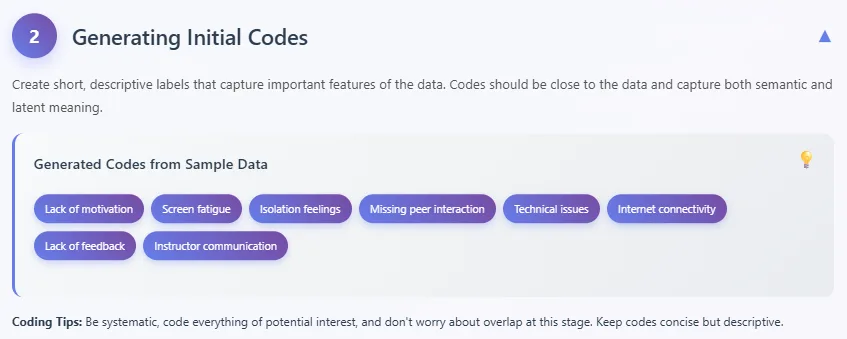
Step 3: Searching For Themes
- Explanation
- At this stage, codes are clustered together into broader themes that address your research aims.
- Themes reflect significant patterns of meaning across the dataset. Researchers may use thematic maps to visualise the developing thematic links.
- Example
- Codes such as Avoidance of social exposure, Fear of being judged, and Physical symptoms in social settings were grouped into the candidate theme Social Avoidance and Hyperawareness.
- Codes such as Small groups as supportive and Seeking one-to-one interactions were grouped into Selective Coping Strategies.
- Codes relating to University counselling not accessible and Peers as main source of help were collated under Barriers and Enablers of Support.
- Reflection
- Here, the analysis became more interpretive. The thematic analysis takes codes beyond description to see how they cluster into meaningful patterns relevant to your research question.
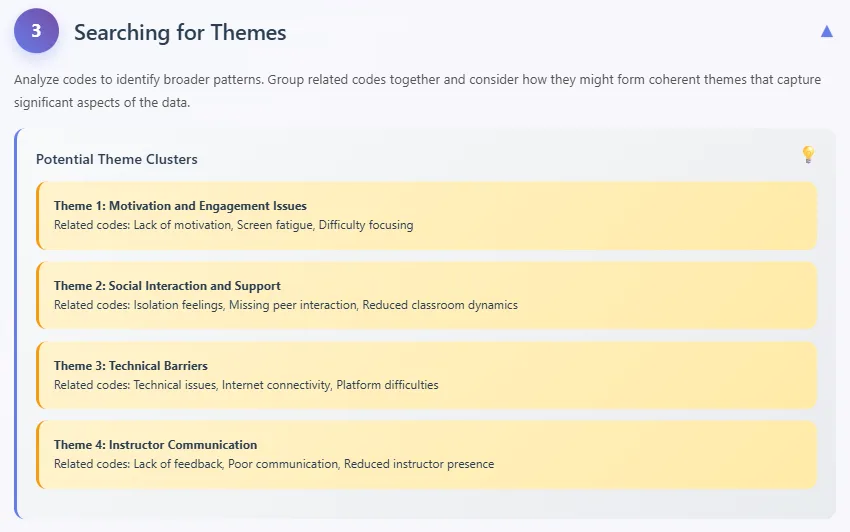
Step 4: Reviewing Themes
- Explanation
- Themes must be checked against the coded data and the dataset as a whole. This ensures they are coherent and relevant to the research questions.
- Some themes may collapse into one; others may split into subthemes.
- Example
- The theme Social Avoidance and Hyperawareness was reviewed and split into two subthemes:
- Fear of Exposure (e.g., avoiding eye contact, avoiding speaking in class).
- Physical and Cognitive Symptoms (e.g., sweating, inability to concentrate).
- The theme Selective Coping Strategies was maintained but expanded to include subthemes:
- Peer-based coping (study groups, friendships).
- Self-help techniques (breathing exercises, positive self-talk).
- The theme Social Avoidance and Hyperawareness was reviewed and split into two subthemes:
- Reflection
- Reviewing transcripts confirmed that these themes were consistent throughout the research process. The analysis using inductive logic was validated: themes were firmly rooted in the data rather than imposed.
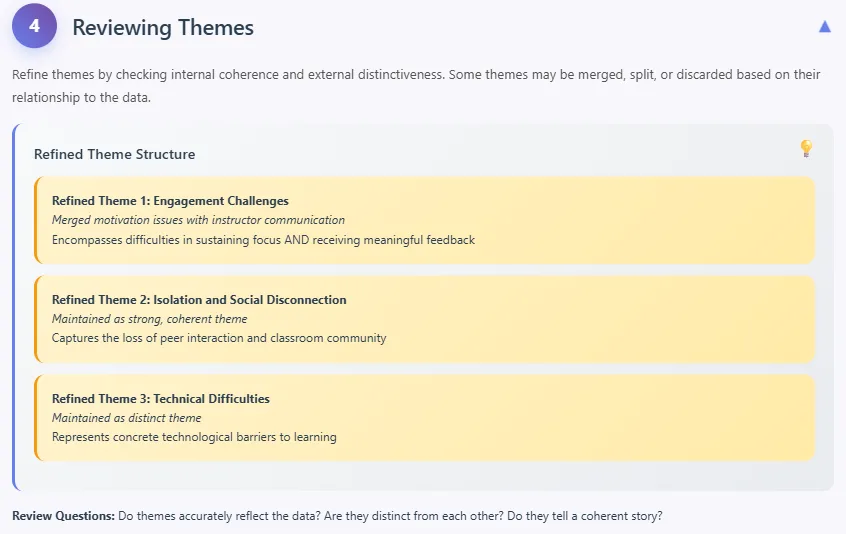
Step 5: Defining And Naming Themes
- Explanation
- Each theme is defined and described, capturing its essence and scope. Names are refined to be concise but clear. Subthemes may also be described.
- This stage involves asking questions about thematic analysis such as: “Does this theme sufficiently capture what participants are expressing?”
- Example
- Theme 1: Social Avoidance and Hyperawareness
- Fear of Exposure: Students described strategies to avoid being noticed. Example: “I always sat at the back so no one would call on me.”
- Physical and Cognitive Symptoms: Anxiety often manifested physically and disrupted focus. Example: “My hands shook so much, I couldn’t take notes.”
- Theme 2: Selective Coping Strategies
- Peer-based coping: Students relied on smaller groups. Example: “With two friends, I felt safe, but seminars made me panic.”
- Self-help techniques: Practical methods helped some manage symptoms. Example: “Breathing slowly before class stopped me leaving.”
- Theme 3: Barriers and Enablers of Support
- Barriers: Services were perceived as inaccessible. Example: “Counselling had a six-week wait; I gave up.”
- Enablers: Peer support was often most effective. Example: “Talking to flatmates made me feel less alone.”
- Theme 1: Social Avoidance and Hyperawareness
- Reflection
- The analysis would now produce a coherent thematic structure. Each theme and subtheme directly linked back to the research questions.
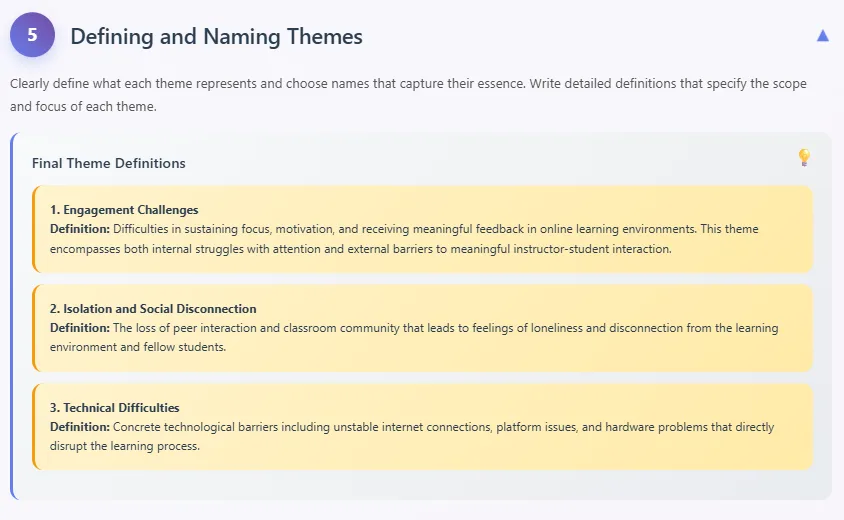
Step 6: Producing The Report
- Explanation
- The final stage is the write-up of the analysis. This integrates data extracts, analytic interpretation, and existing literature.
- A well-written report does not just list themes but tells a story about the dataset.
- Example
- The overall analysis revealed how social anxiety shaped students’ academic and social lives. Themes were supported by vivid extracts: Theme 1: Social Avoidance and Hyperawareness “Even in online seminars, I muted myself quickly; I was scared of saying the wrong thing.” This highlights how anxiety influenced behaviour across different settings. Theme 2: Selective Coping Strategies “Group chats with friends were my lifeline; I didn’t feel I had to perform.” This shows how selective social interactions mitigated anxiety. Theme 3: Barriers and Enablers of Support “I felt the university counsellors didn’t have time for people like me.” This underscores structural barriers and the reliance on informal networks.
- Reflection
- The analysis became not only descriptive but interpretive, connecting themes to broader debates in psychological research on anxiety and student well-being.
- This is an example of Braun and Clarke’s six-step method, showing how a q’ qualitative approach systematically transforms qualitative information into meaningful insights.
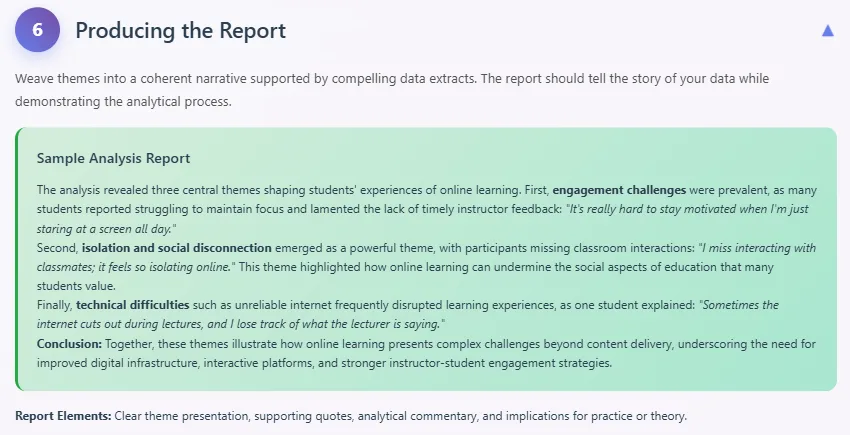
Key Takeaways
- This worked thematic analysis example demonstrates how Braun and Clarke’s approach can be applied to psychological research.
- From familiarisation to final write-up, the research process showed how students’ experiences of social anxiety could be systematically explored and interpreted.
- Thematic analysis is often chosen in psychology because it is flexible, accessible, and capable of producing rich, detailed insights.
- As this example illustrates, thematic analysis is a good method for projects where the aim is to answer the research questions in depth, while also remaining transparent and reflexive.
- By following these six phases—familiarisation, coding, searching for themes, reviewing, defining and naming, and producing the report—psychologists can ensure their analysis tends to be rigorous, coherent, and valuable to both theory and practice.
- Ultimately, this detailed worked example underscores why thematic analysis takes such a central place in qualitative research.
Sources
- Using thematic analysis in qualitative research. Available at: https://www.sciencedirect.com/science/article/pii/S2949916X25000222
- A worked example of Braun and Clarke’s approach to reflexive thematic analysis. Available at: https://link.springer.com/article/10.1007/s11135-021-01182-y
- The approach and application of analysing inductive and deductive datasets: a worked example using reflexive thematic analysis. Available at: https://www.tandfonline.com/doi/full/10.1080/14780887.2025.2499265
- Need expert support with your thematic analysis? At Best Dissertation Writers, we specialize in helping students and researchers transform raw data into clear, well-structured themes. Whether it’s coding, applying Braun and Clarke’s 6-step process, or writing a complete analysis chapter, our team is here to guide you every step of the way.
Further Reading on Thematic Analysis and Content Analysis – Click to Read
- Content Analysis: Definition, Steps, and Examples
- Thematic Content Analysis: How to Identify Patterns in Data
- Themes in Qualitative Research: Understanding Content and Thematic Analysis
- Content Analysis vs. Thematic Analysis: Key Differences Explained
- How to Write a Thematic Analysis Essay: A Step-by-Step Guide
- Thematic Analysis: A Practical Guide for Students and Researchers
What People Also Ask About Thematic Analysis Example
What are examples of thematic analysis?
Examples of thematic analysis often come from qualitative research projects where interviews, focus groups, or open-ended surveys are analysed. For instance, in a study on online learning, themes might include “technical barriers,” “lack of motivation,” and “feelings of isolation.” Another example could be in healthcare research, where patient interviews reveal themes like “trust in providers,” “communication challenges,” and “treatment adherence.” These examples show how raw data can be coded and grouped into meaningful themes that reflect broader patterns.
How do I write a thematic analysis?
Writing a thematic analysis involves following Braun and Clarke’s six-step framework. First, immerse yourself in the data by reading repeatedly. Second, generate initial codes that label important features. Third, collate these codes into potential themes. Fourth, review and refine themes to ensure they fit the dataset. Fifth, define and name themes clearly. Finally, produce your report by weaving together evidence, using direct quotes to illustrate themes, and linking the findings to your research question and existing literature.
Can I use ChatGPT to do thematic analysis?
ChatGPT can be a helpful companion in thematic analysis, but it should be used cautiously. It can assist in brainstorming codes, drafting theme descriptions, or summarizing interview data. However, true thematic analysis requires reflexivity, critical interpretation, and familiarity with your research context. ChatGPT cannot replace your role as the researcher, since meaning-making is inherently subjective and context-dependent. You may use it to refine your writing or check clarity, but final decisions on coding and themes should remain yours.
What are the three types of thematic analysis?
The three main types of thematic analysis often discussed are reflexive thematic analysis, codebook thematic analysis, and coding reliability thematic analysis. Reflexive thematic analysis, developed by Braun and Clarke, emphasizes flexibility and researcher subjectivity. Codebook approaches rely on predefined frameworks or coding manuals, often used in team-based research. Coding reliability approaches are more structured and emphasize consistency between coders, sometimes supported by inter-coder reliability checks. Each type differs in its philosophical assumptions and level of flexibility in interpretation.
